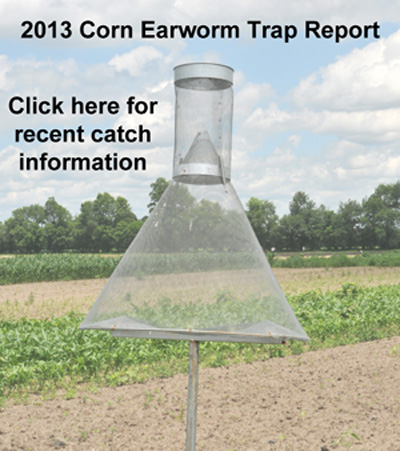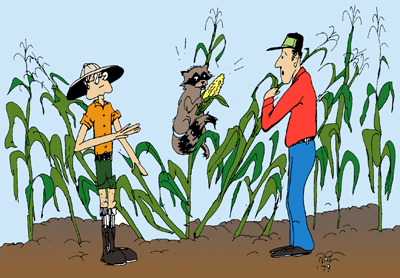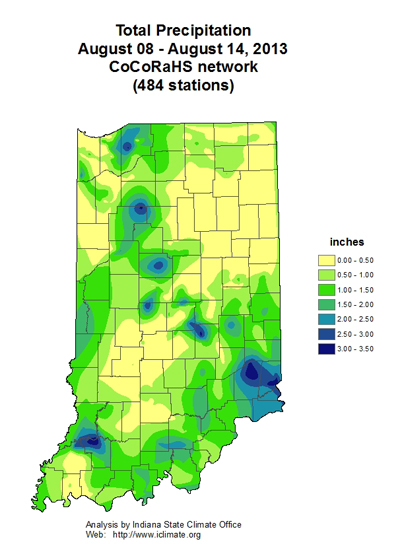USDA-NIFA Extension IPM Grant
Pest & Crop Newsletter, Entomology Extension, Purdue University
Insect Pest Update: Mostly Good, Some Surprises – (Christian Krupke and John Obermeyer)
• Overall, lower insect populations have led to minor crop damage.
• Bean leaf beetle and soybean aphid are in many fields, low levels so far
• Producers checking on some out-of-way cornfields have found unpleasant surprises!
With projected record crop yields for Indiana, it stands to reason that insect pressure and damage have been low in 2013. But there are still opportunities for a few pests to cause problems, mostly in soybeans.
We’ve had a report of significant bean leaf beetle populations feeding on R5 soybean in northern Indiana. The minor pod scarring wasn’t as big a concern as is some pods beginning to be clipped from the stem. Generally the second-generation beetles prefer feeding on foliage until senescence begins, then they focus on the green pods. Why these beetles are feeding on the peduncle while foliage is plentiful and green remains a mystery…obviously they haven’t read the book!
Soybean aphid colonization started in northern county fields a few weeks ago, coupled with the mild temperatures. We anticipated some outbreaks by this time, but have not seen many so far. In fact, except for where conditions are abnormally dry, very few fields have seen levels of 250 aphids or more per plant. We appreciate the updates from many concerning this pest, and that they realize that many soybean fields are still in the vulnerable pod set/fill period that scouting should continue up through the R5 growth stage.
The biggest surprise recently has originated in a few cornfields, mostly in northern counties…that being armyworm damage. A few “back 40” fields located next to grass pastures or small grains were visited by producers and found that very little of the lower canopy was left. Sometimes the denuded corn was only on the end rows, other times throughout small acreage fields. The mystery to agronomists, checking on these fields, were to determine what caused the damage, as worms were no longer present. This same phenomenon has occurred in Kentucky, as reported in their Pest News, by colleague Doug Johnson. Should you be interested, they run through a nice “who done it” scenario determining that indeed this was armyworm (not fall armyworm) that damaged the fields <http://www2.ca.uky.edu/agcollege/plantpathology/extension/kpn/current.html> Admittedly this late-season armyworm damage is unusual, but it does happen time to time. These armyworms generally will not feed on the ear and economic damage is generally minimal. This time, the old text book got it right!
Please let us know what other interesting oddities you might be finding – often others will find the same thing, but just need a heads up. Happy Scouting!
Unpleasant surprise, late-season armyworm damage in "Back 40" field. (Photo Credit: Mark Kepler, Fulton County CES).
![]()
![]()
Click here to see the Black Light Trap Catch Report
![]()
Western Bean Cutworm Adult Pheromone Trap Report
![]()
Unseasonably Cool Weather: Good or Bad for Corn During Grain Fill? - (Bob Nielsen) -
Recent early mornings with temperatures hovering in the upper 40’s°(F) and afternoon highs less than 80F are certainly not synonymous with those we typically experience during these “dog days of summer”. While comfortably pleasant for us humans, there are those who question whether such unseasonably cool temperatures are good or bad for the corn crop as it progresses through the important grain filling period.
All things equal, cooler temperatures during grain fill typically result in heavier kernels and higher grain yield than do warmer temperatures, especially stressfully hot temperatures. Even though the rate of grain filling per day is slower when temperatures are cool, the duration of the grain filling period (number of days) is longer. The advantages of a lengthy grain fill period typically outweigh the disadvantages of a slower grain fill rate per day.
Record statewide corn yields in Indiana have generally occurred in years where average temperatures during July and August were cooler than normal. The greatest positive departures from trend yield since 1990 occurred in 1992 (+15.8%), 1994 (+10.4%), 2001 (+9.5%), 2004 (+13.7%), and 2009 (+9.3%). Four of those five growing seasons were characterized by average monthly temperatures for August ranging from 1.7 to 4.7°F below normal.
Graybeards like myself consider 2004 to have been the nearly perfect growing season, in part due to the season-long moderate temperatures. Daily average temperatures across Indiana in July and August of that year were 2.1 and 3.4°F below normal. Across the Midwest, July 2004 ranked as the 9th coldest and August as the 3rd coldest since 1895 (Midwest Climate Watch). In eastcentral Indiana (Farmland), half of the daily low temperatures recorded during July and August of 2004 were below 60°F and four days dropped to 46°F (Fig. 1). Statewide grain yield averaged 13.7% above the trend yield for that year and set a new record (up to that year) of 168 bu/ac.
So, what does this all mean for the current 2013 growing season? By comparison, as of mid-August, there have been 16 days since July 1 with daily low temperatures in the 50’s and a couple down into the 40’s at the same eastcentral Indiana reporting station (Fig. 2). Average daily temperatures across Indiana for the past 30 days have ranged from 1 to 3°F below normal.
While it is true that some fields pollinated during the warm, muggy days of mid-July, most of the state’s crop pollinated during much cooler temperatures (Fig. 1). While scattered reports have been received describing incomplete or scattered pollination problems, the bulk of the state’s corn crop has pollinated well. Much of the state’s crop has escaped severe stress during the crucial 1 to 2 weeks following pollination and so kernel survival has generally been quite good. Consequently, I believe the table is set for maximizing kernel numbers and ear weights in many fields.
Does this mean that we can expect another record-setting statewide average yield? Not necessarily so............................ Whoa! Why not?
We tend to forget about the excessive rainfall events that occurred throughout the state early in the season. Those rains prior to planting that provided such good opportunities to compact the soil with pre-plant field operations and with the planting operation itself. Those rains that resulted in large, drowned out areas in fields. Those rains that resulted in extended periods of soggy, saturated soils that took its toll on root development and health. Those rains that resulted in the loss of soil nitrate by leaching or denitrification. Consequently, many fields are not uniformly healthy. Stress from saturated soils during the ear size determination period may have compromised the top end ear size potential before pollination even occurred. Excessively cloudy weather during pollination may have reduced photosynthetic rates enough to interfere with the success of ovule fertilization and initial kernel development. In other words, in contrast to the record-setting year of 2004, the 2013 growing season has not been perfect.
I suspect that Indiana will end up with a solid overall average yield in spite of the early season stresses, in large part fueled by the favorable weather during pollination and grain fill. In essence, this is what USDA-NASS told us in their initial August yield estimate for Indiana. That being said, “it ain’t over until it’s over”, meaning that the situation could still change.
By now, barely half of the state’s crop has probably reached the dough stage of kernel development. At that stage, nearly half of the kernel dry weight is yet to be determined. Most fields have at least another 30 days of grain filling remaining before physiological maturity (kernel black layer) occurs. Some fields will require more than 30 days to reach physiological maturity. A lot could still happen, both favorable and unfavorable.
Many areas of the state have received less than normal rainfall for the past 30 days. The U.S. Drought Monitor does not currently (Aug 13) depict any areas of drought in Indiana, but compacted areas of fields, shallow-rooted crops, and crops in soils with naturally low water-holding capacity are in fact showing symptoms of drought stress. The current forecast for the remainder of the month is for above normal temperatures. Without meaningful amounts of rainfall, temperatures significantly above normal will cause similar stress in more fields around the state and interfere with the successful completion of the grain filling period.
Figure 1. Historical air temperatures in eastcentral Indiana (Farmland) from May - Sept. 2004. Source of temperature graphic: Weatherspark.com. Annotations by R.W. Nielsen.
Figure 2. Historical air temperatures in eastcentral Indiana (Farmland) from May - Sept. 2004. Source of temperature graphic: Weatherspark.com. Annotations by R.W. Nielsen.
Figure 3. Average temperature departure from mean from l7/16/13 to 8/14/13. Graphic source: Midwest Climate Watch.
Do you think this has been factored into the USDA-NASS yield estimates?
![]()
Weather Outlook by NWS OHRFC – (James Noel, NOAA/NWS/Ohio River Forecast Center) –
Fairly good growing conditions will continue across Indiana the into early August.
Temperatures and rainfall will be slightly below normal through August 3.
From August 4-15, more summer-like weather will build in with a return of a tropical air-mass. This will allow temperatures to return to normal or above normal and rainfall to normal or above normal.
The latest 2 week rainfall map is located here: <http://www.erh.noaa.gov/ohrfc/HAS/images/NAEFS16day.pdf>.
Right now, August is shaping up to be about normal from all the latest indications.









